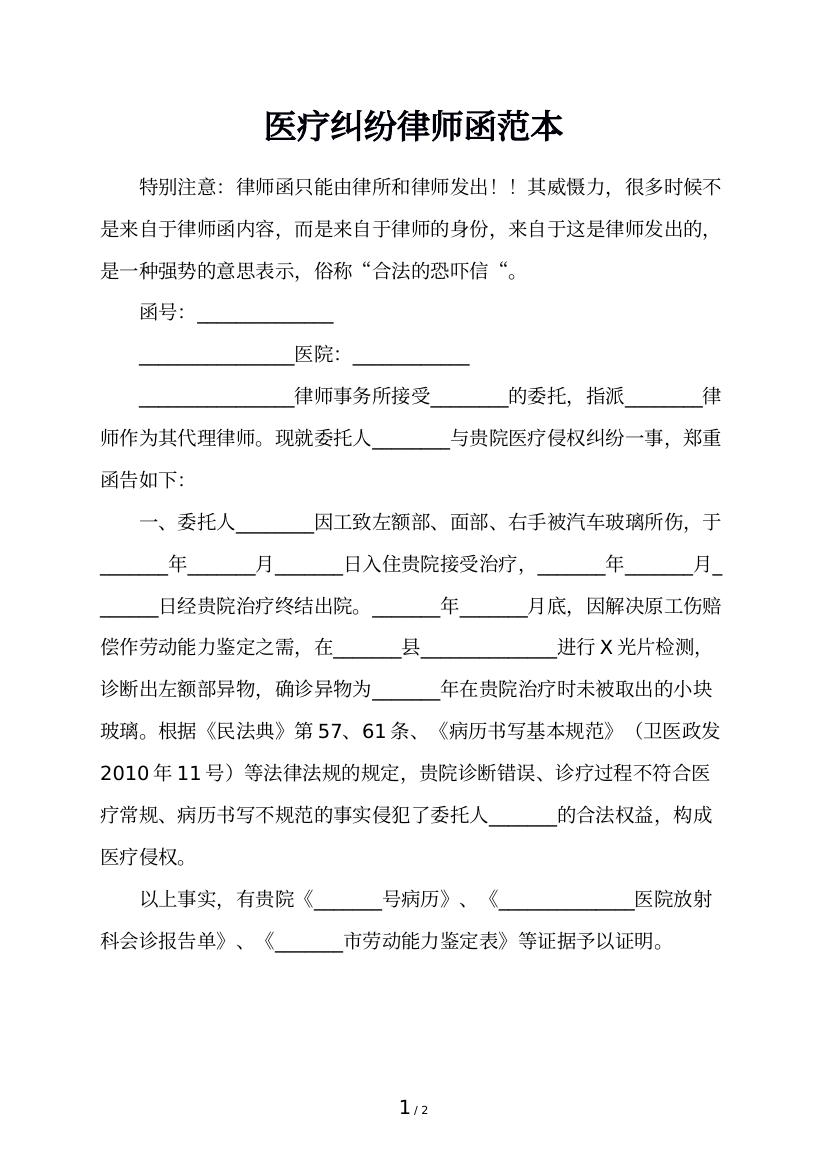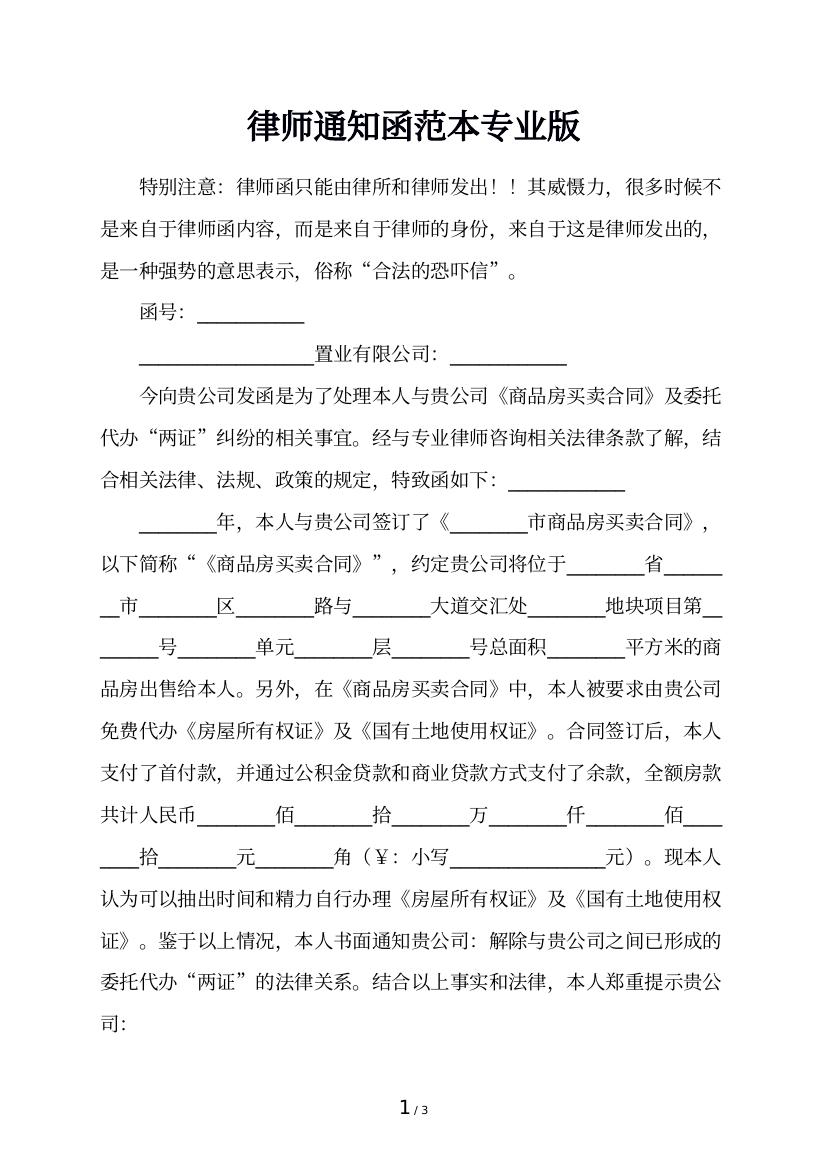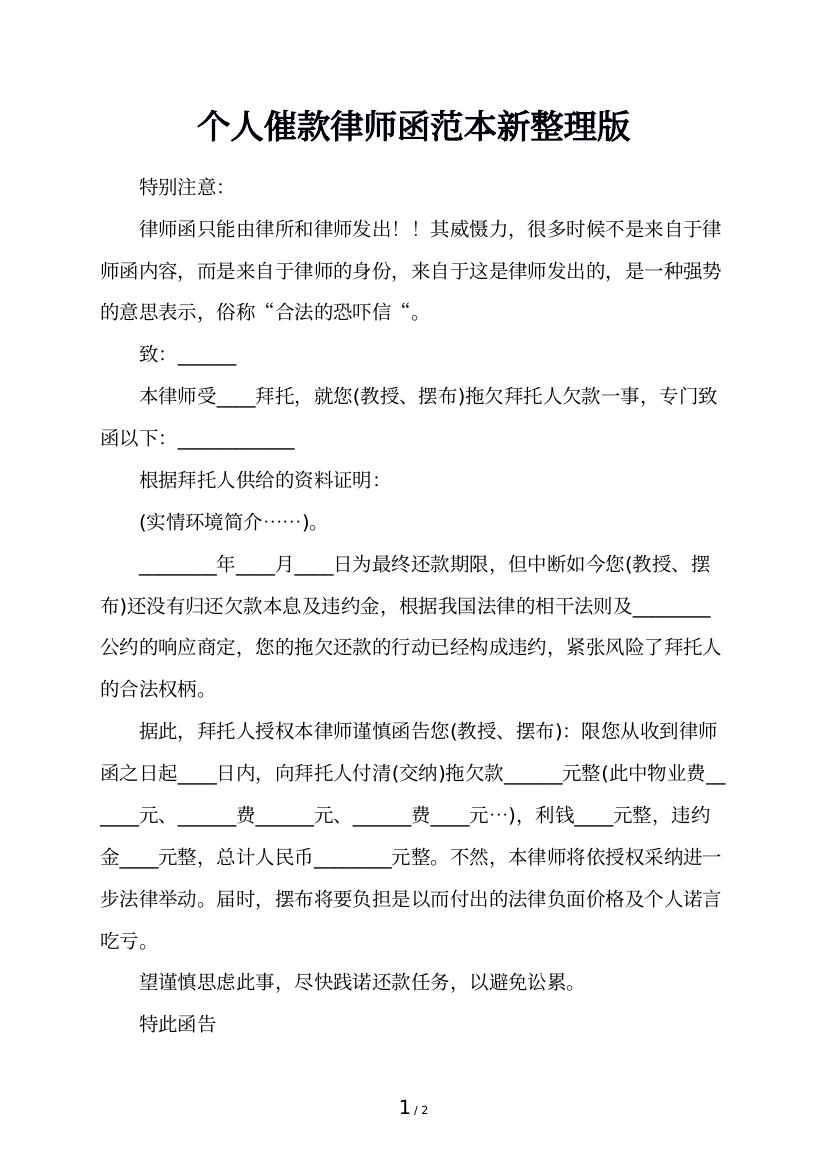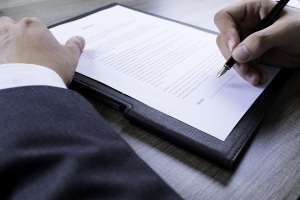如何撰写律师函?(英)
TO WRITE LETTERS NONLAWYERS WILL READ
Note: This article is for background purposes only and is not intended as legal advice.
Why do people hate to get letters from lawyers? They carry bad news. They mean serious business. They\'re hard to understand. They use strange words. They carry the inherent threat of suit.
Why do lawyers send such letters? They mean serious business, and they intend to sue.
But must they use those ancient, strange words and be so hard to understand, or can lawyers express serious business and imminent suit using words everyone knows?
Whether writing a demand letter to a contract breacher, an advice letter to a client, or a cover letter to a court clerk, the letter fails if the person receiving it cannot understand what it says.
All of these letters have one thing in common: They are not great literature. They will not be read in a hundred years and analyzed for their wit, charm or flowery words. With any luck they will be read just once by a few people, followed quickly by their intended result, whether that be compliance, understanding or agreement.
Lawyers are Letter Factories
Lawyers write many, many letters. An average for me might be five letters a day. This includes advice letters, cover letters, demand letters, all sorts of letters. Some days have more, some have less, but five is a fairly conservative average, I would think. Five letters a day for five days a week for fifty weeks a year is 1,250 letters a year. This is my 25th year in practice, so it is quite conceivable that I have written 31,250 letters so far.
Why do lawyers write so many letters? A primary reason lies within the ethics of our profession. Florida Bar Rules of Professional Conduct Rule 4-1.4 says:
\"A lawyer shall keep a client reasonably informed about the status of a matter and promptly comply with reasonable requests for information.\"
\"A lawyer shall explain a matter to the extent reasonably necessary to permit the client to make informed decisions regarding the representation.\"
While clients can be kept informed and given explanations orally, lawyers certainly know the value of the printed word over the spoken word: it is not as easily forgotten or misunderstood. Letters also create a record of advice given, which is useful to both the lawyer and the client. That is why letters are the preferred method of keeping clients informed and giving clients explanations.
Some Things To Do Before Writing
Before you start writing the letter it makes sense to do some preliminary background work.
Find a letter form. Find a similar letter you have sent in the past, or see the Appendix to this article for sample engagement, cover, demand, contract negotiation, contract advice, and fax letters.
Review prior letters to this recipient. In a busy world, it is easy to forget. Review prior letters to remind yourself where you are in the work process, what has already been said, and what remains to be said. This will give your letter direction and purpose.
Do not send a letter to another lawyer\'s client without that lawyer\'s consent. Before sending the letter, find out if the nonlawyer is represented by someone else. Start by asking your client. Florida Bar Rules of Professional Conduct Rule 4-4.2 says:
\"In representing a client, a lawyer shall not communicate about the subject of the representation with a person the lawyer knows to be represented by another lawyer in the matter, unless the lawyer has the consent of the other lawyer.\"
Outline your thoughts in a checklist. Before turning on your computer or dictating machine, pull out a yellow pad and jot down the main points for your letter. List what you want the letter to say. Write the points in any order; write them as they come into your mind. You can rearrange them when you write the letter. Right now you\'re just making a checklist for writing the letter.
Keep the legal pad close at hand. When you run out of ideas for the checklist, put the pad at the side of your desk. New ideas always spring forth when writing. Jot these down on the pad as you write the letter; they are easily forgotten.
Simple Stuff That Will Make You Look Dumb If It\'s Wrong
Letters begin with boring things like the date and recipient\'s name and address, but if any of these are missing or wrong the letter writer will look pretty careless, to say the least. So be careful when starting the letter, and you can even include some extra things that will make the letter even better than the regular letters the recipient receives.
Date your letter. Date your letter the day you write it, and send it the same day. Undated letters are difficult to reply to. I usually reply to them by saying, \"This is in reply to your undated letter that I received in the mail on 24 June 1999.\"
Consider using the international dating convention of day-month-year rather than the U.S. convention of month-day-year. As reported in the 1 June 1999 Wall Street Journal:[page]
\"The quirky U.S. style of date-writing is giving way to the day-first standard used by most of the world.
…… Both the MLA style guide and the Chicago Manual of Style support the day-first format. \'You get rid of the comma that way,\' says Joseph Gibaldi, director of book acquisition for the MLA in New York.\"
If you are sending a fax or email, then type the time next to the date. While letters \"cross in the mail\" in days, faxes and emails \"cross in the wires\" in hours and minutes.
Remind your client to preserve attorney-client confidentiality. Sometimes clients show your letters to others without realizing they can lose the attorney-client privilege of that communication. Add this phrase at the top of the letter to remind them not to do this:
CONFIDENTIAL ATTORNEY-CLIENT COMMUNICATION
DO NOT COPY OR DISCLOSE TO ANYONE ELSE
If the letter is written during or in anticipation of litigation, the following phrase can be used:
CONFIDENTIAL ATTORNEY-CLIENT COMMUNICATION
AND WORK PRODUCT
DO NOT COPY OR DISCLOSE TO ANYONE ELSE
Be sure to use the recipient\'s correct legal name and address. Your letter may be relied upon for its accuracy, so be accurate. Verification of names can be obtained from the public records, the phone book, or the webstes. And when it comes to middle initials, never rely on your memory or guess at it because most of the time you\'ll be wrong.
Indicate the method of delivery if other than mail. If being faxed, include the fax number and telephone number. If being sent by FedEx, state whether it is by overnight or second day. If being sent by email, state the email address. This will make it easy for your staff person to send it to the correct place, and it will document for your file how it was sent.
Include a fax notice. When sending by fax, include a notice in case it is sent to the wrong number. Here is the notice I use at the top of my letterhead when sending a fax:
NOTICE: This is privileged and confidential and intended only for the person named below. If you are not that person, then any use, dissemination, distribution or copying of this is strictly prohibited, and you are requested to notify us immediately by calling or faxing us collect at the numbers above.
Date Sent ________ Time Sent ________ Number of Pages ________
Person Who Conf\'d Receipt _________
After sending a fax, call the recipient to confirm receipt and write that person\'s name in the space provided. Never rely on the fax machine itself to confirm a fax transmission; fax machines do not yet have the credibility of a human witness.
The Corpus of the Litterae
The body of the letter is why you are writing it. You succeed by leaving the reader with full knowledge of why you wrote the letter and what it means. You fail by leaving the reader dumbfound and clueless as to why you sent such a letter. While most letters fall somewhere in between these two extremes, following these suggestions will keep your letters on the successful end of the scale.
Identify your client. It is important to let others know who is your client at the earliest opportunity. This accomplishes a great deal. First, it tells the reader that your client has a lawyer. This makes your client happy because most clients want the world to know they have a lawyer. Second, it tells the reader that you are not the reader\'s lawyer. This makes your malpractice carrier happy because it\'s one less person who\'s going to sue you claiming they thought you were representing them when, in fact, you were not.
Identifying your client is an ethical concern, as well. Florida Bar Rules of Professional Conduct Rule 4-4.3 says:
\"In dealing on behalf of a client with a person who is not represented by counsel, a lawyer shall not state or imply that the lawyer is disinterested.\"
Therefore, the first time you write someone a letter, the letter should open with the following sentence: \"I represent _________.\" After that, every time you write another letter reconfirm who you represent by referring to your client by name and as \"my client.\"
State the purpose of the letter. Why leave the reader guessing? Go ahead and say right up front why you are writing the letter. Here are some opening sentences:
\"The purpose of this letter is to _________.\"
\"This letter is to inform you that _________.\"
\"My client has instructed me to _________.\"
\"This is to confirm that _________.\"
\"This confirms our phone conversation today in which _________.\"
If there are any enclosures, list them first. Listing enclosures at the beginning of the letter will make it easier for your staff to assemble them and for the reader to check to be sure all was received. This is much easier than having to read an entire, perhaps lengthy, letter to ascertain what are the enclosures.
The enclosures should be described with specificity so that there is later no question as to what was enclosed. At a minimum, the title and date of each document should be listed. If the document was recorded, then the recording information should be included. Whether the document is an original or a copy should also be specified. The following is an example:[page]
\"Enclosed are the following documents from your closing held on ___/___/1999 in which you purchased the home at _________, St. Petersburg, Florida, from _________:
Warranty Deed dated ___/___/1999 and recorded on ___/___/1999 at O.R. Book ____, Page ____, _________, County, Florida (original)
Title Insurance Policy issued on ___/___/1999 by _________ on _________ as policy number _________ (original)
HUD-1 Settlement Statement dated ___/___/1999 (original)\"
Outline the letter as separately numbered paragraphs. Each paragraph of the letter should state a separate thought, comment, point or concept. No paragraph should be longer than four or five short sentences. If the paragraph is longer, then separate it into subparagraphs. The paragraphs should flow in logical, organized fashion. It is not necessary to write them all at once; you can write them as you think of them. Try to group related concepts in the same paragraphs or in adjacent paragraphs. See the Appendix for sample letters.
Give each paragraph a title and underline that title. Think of this as the headline for a newspaper article. This makes it easy for the reader to scan the letter and choose how to more fully read and digest its contents. This also makes it easier for you later when you see the letter in your file and try to remember why you wrote it.
Complete each paragraph by writing what applies to that paragraph. This is simple. You learned this in elementary school. Just explain in words what you want to say about each concept or comment you placed in your outline.
If this is a letter to your client, include ideas that occur to you as you write. Many ideas will occur to you as you write: things that could go wrong with a business deal, things that might happen in the future, things that happened in the past, ways to structure things better. Write these in your letter even if they are not strictly legal advice. Florida Bar Rules of Professional Conduct Rule 4-2.1 says:
\"In rendering advice, a lawyer may refer not only to law but to other considerations such as moral, economic, social, and political factors that may be relevant to the client\'s situation.\"
If this is a letter to a nonclient, do not offer any advice. The letter should accomplish its purpose of providing information, making a demand, etc., without giving legal advice to the recipient. The comment to Florida Bar Rules of Professional Conduct Rule 4-4.3 says:
\"During the course of a lawyer\'s representation of a client, the lawyer should not give advice to an unrepresented person other than the advice to obtain counsel.\"
State your assumptions. Whether or not this is an opinion letter, set forth the factual assumptions and statutes you rely upon in giving your opinion or advice. It is customary for opinion letters to recite the facts upon which the opinion is based and the statutes and case law, as well. This is something that every letter providing advice or opinion can include in order to avoid future misunderstanding. Every opinion and all advice is predicated upon facts and law. Stating the assumed facts and applicable law in the letter merely makes known to the reader what the writer understands to be true. This then places an obligation on the reader to inform the writer if any of the assumed facts is not accurate, which might change the opinion or advice.
Place instructions to clients in bold type. This will make it easier for the client to follow up on your letter and do as advised.
Close the letter with a final paragraph. The last paragraph will be one of the following:
Summary of advice: \"To summarize, I advise that you……\"
To do list: \"Therefore, please do the following:……\"
Demand: \"Therefore, my client demands that you immediately cease and desist……\"
Simple close: \"If you have any questions, please call me.\"
Playing with the Words
Why does it take lawyers so long to write letters? Because we play with the words. We write, rewrite, move around, delete, cut and paste the words over and over and over again until we are happy with the way it sounds. That\'s the art of legal writing. It\'s like Picasso painting over the same canvas again and again, transforming it from one painting to another and then to another until finally he is satisfied with the result. Not always 100% satisfied, but good enough for it to go out the door and into the world. That\'s why writing is an art. And that\'s also why more copies of WordPerfect were sold to lawyers than any other industry. So here are some things to play with.
Write in short sentences. Short sentences are easier to understand than long ones. \"Short, crisp sentences in a language accessible to lay people.\" This is the Associated Press\'s description of the writing style of the late Lord Alfred Thompson Denning, who was one of Britain\'s longest-serving appeals judges when he died at the age of 100 in March 1999. The same style Lord Denning used in writing appellate opinions should be used in writing letters to nonlawyers.[page]
It\'s okay to use jargon; just explain it. We hear all the time that lawyers use too much jargon. But some concepts need the jargon. Like nunc pro tunc (which means now for then and is a wonderful concept that recognizes the inherent power of a court to correct its records by entering an order effective as of a prior date) and per stirpes (which means through representation and indicates a manner of taking title from a decedent).
Every profession has its jargon. That\'s not bad. It\'s part of our identity. It\'s a form of shorthand. It\'s a form of common knowledge among professionals. If my physician failed to use jargon in describing a medical condition, I would probably wonder if I had the right expert. A good professional not only knows the jargon, but can also explain it to a layman. Therefore, show your expertise. Use the jargon when necessary, but explain it when you use it.
Repeat yourself only when repetition is necessary to improve clarity or to emphasize a point. Ambiguity can created by saying the same thing more than once; it is almost impossible to say it twice without creating ambiguity.
When explaining a difficult concept, describe it from three directions. The only time repetition is helpful is when explaining a difficult concept. Each time you explain it you can make it a little more clear if you describe it from a different direction, perspective or point of view.
Write in active tense, rather than passive. Active tense is interesting; passive is boring. Active tense sentences are shorter and use words more efficiently, and their meaning is more apparent.
Watch where you place modifiers. When adding a modifier like \"active\" before a compound of nouns like \"termites and organisms,\" be sure to clarify whether you intend the modifier to apply to both nouns or just the first one. If you intend it to apply to both, use parallel construction and write the modifier in front of each noun. If you intend it to apply to just one noun, place that one noun at the end of the list and the modifier directly in front of it.
Write numbers as both words and numerals: ten (10). This will reduce the chance for errors. The Associated Press reported on 18 June 1999, that a comma in the wrong place of a sales contract cost Lockheed Martin Corp. $70 million: \"An international contract for the U.S.-based aerospace group\'s C-130J Hercules had the comma misplaced by one decimal point in the equation that adjusted the sales price for changes to the inflation rate.\" Perhaps writing out the number would have saved the day.
When you write \"including\" consider adding \"but not limited to.\" Unless you intend the list to be all-inclusive, you had better clarify your intent that it is merely an example.
Don\'t be creative with words. Legal letter writing is not creative writing and is not meant to provoke reflective thoughts or controversies about nuances of meaning. Legal writing is clear, direct and precise. Therefore, use common words and common meanings.
Be consistent in using words. If you refer to the subject matter of a sales contract as \"goods\" use that term throughout the letter; do not alternately call them \"goods\" and \"items.\" Maintaining consistency is more important than avoiding repetition.
Be consistent in grammar and punctuation. Don\'t rely on the rules of grammar. The rules of grammar that you learned in school are not universal. The readers of your letter may have learned different rules. Write the letter so that no matter what rules they learned the letter is clear and unambiguous.
Be consistent in your use of grammar. Be aware of such things as where you put ending quote marks, whether you place commas after years and states, and similar variations in style. Many rules of grammar are a matter of choice, but your choice should be internally consistent within the letter.
Define a word by capitalizing it and putting it in quotes. Capitalizing a word indicates that you intend it to have a special meaning. The following is a sample clause for defining a term:
\"Wherever used in this letter, the word \"Goods\" shall mean the goods that _________ agreed to purchase from _________ under the Contract.\"
Define words when first used. Instead of writing a section of definitions at the beginning or end of a long letter, consider defining terms and concepts as they appear in the letter. This will make it easier for the reader to follow.
Avoid needless and flowery words. Think of elementary school when you had to reduce fractions to the \"lowest common denominator.\" That\'s what good writing is all about. A letter written for the lowest common denominator is understood by every reader. Eliminate needless words. Avoid flowery words.
Be direct and frank. There is no sense beating around the bush in legal letter writing. Just say what you mean. If you leave the reader wondering what you mean, your letter will only stir the imagination instead of prompting some action.
Study The Elements of Style. The full text of the 1918 classic by William Strunk is now available on Columbia\'s Internet site at http://www.columbia.edu/acis/bartleby/strunk. This means that even if you left your copy on your bedstand at home, you can quickly go online and search the full text of The Elements of Style, where you will find these simple rules among others (as you can see, I am a old student of this text):[page]
\"Make the paragraph the unit of composition: one paragraph to each topic.\"
\"As a rule, begin each paragraph with a topic sentence; end it in conformity with the beginning.\"
\"Use the active voice.\"
\"Put statements in positive form.\"
\"Omit needless words.\"
\"Avoid a succession of loose sentences.\"
\"Express co-ordinate ideas in similar form.\"
\"Keep related words together.\"
\"In summaries, keep to one tense.\"
\"Place the emphatic words of a sentence at the end.\"
Cleaning Up
Now that you have the letter written, it\'s time to do some cleanup work before you hit the send button.
Let your secretary or paralegal read it. Not only will your staff frequently find spelling and grammar errors missed by your word processor\'s spell checker, but they will find inconsistencies and confusing areas that you missed when drafting.
Number every page of the letter, and staple the letter. If the letter is more than one page long, then it is important to number the pages because they will invariably get out of order. Place the following at the top left corner of each page after the first:
Recipient\'s name _________
Date _________
Page _________
Sign the letter in blue ink, not black ink. This will make it easier to differentiate the signed original letter from photocopies, and it will make it more difficult for someone to change your letter after you send it.
Computerized Letter Writing Tips
My wife Cathy said I have to put this way at the end here because this article is about letter writing and not computers. She thinks I love wrestling with computers as much as I love playing with words. She\'s right. In my first three drafts this section was on page one.
But I think anyone who likes to play with words should play with them on a computer. That\'s where they really dance. And when you\'ve written 31,250 letters, as my earlier calculations indicate I may have written in my practice so far, a fourth of them before I started writing letters on computer in 1980, you really begin to appreciate the ability to cut and paste text from prior letters. So here are my tips for anyone still around willing to listen.
Write your own letters on a computer. If you have not yet joined the computer revolution, do it now. Get a computer for no other reason than writing letters. You will never again find yourself explaining to your client why the letter you dictated three days ago has not been mailed yet.
Get Microsoft Word or Corel WordPerfect. You will need good word processing software. The latest versions are Microsoft Word 2000 and Corel WordPerfect 2000. I have both, but I still use Wordperfect 5.1 for DOS for 99% of my work. My fingers know the special codes so well that it\'s faster for me to write in this older program. I can still convert the file format to any other one using one of the new 2000 programs which can read the old 5.1 files.
Get voice recognition software if you cannot type. If you never learned to touch type, there is finally reliable software to do it for you. Voice recognition software allows you to dictate directly to your computer. The software is so good that WordPerfect 2000 is sold in a bundle with one brand. You can also purchase this software with an optional hand-held recorder so that you can dictate the old-fashioned way and then transfer it to your computer to transcribe. The two most-advertised brands of software are Dragon Naturally Speaking and L&H VoiceXpress.
Set up a separate directory for each client. If you create a directory (folder) on your computer for every client, you can keep all letters, documents and work for that client in one easy-to-find place, just like your paper file folder. The client\'s last name can be used as the directory name. Thus, all letters, wills, contracts, spreadsheets, etc., for John Doe can be kept on your computer\'s directory named DOE.
Keep all letters in one computer file. Just as you keep copies of all letters in a paper file folder, you should keep copies of all letters on your computer in the directory for that client. The easiest way to do this is not to start a separate computer file for each letter sent to someone. Instead you just add the new letter to the existing computer file containing other letters to that person. I find that it works best to add new letters at the top of old letters, rather than at the bottom. Then your computer file is like a paper folder since new letters are added at the top where you see them first. This is easy to do on your computer: you just start a new page at the top of the existing letter and write the new letter there.
Name letters to clients LETTERCL and name letters to non-clients with the recipient\'s last name. If you name the file with the recipient\'s last name, you can easily find the letter later when you want to read it on your computer without having to pull the file. For example, a letter to non-client Mary Smith would be given the computer file name SMITH. The only exception is that I name all letters to my clients LETTERCL rather than the client\'s last name because their computer directory is already named their last name. I also do this because it saves me time finding the file if the client is a corporation or there are multiple clients.[page]
Copy text from prior letters. More than half the letters you write are not first letters to a recipient, but are follow-up letters that either remind the recipient of pending work to be done or continue discussion of a matter previously opened. The other half have at least one thing in common: the letter\'s opening with the recipient\'s name and address and the closing with your name. There is no need to retype all of this text in your new letter. Using block and copy (cut and paste) commands you can easily copy the recipient\'s name and address and usable text from a prior letter into your new letter. You can then modify that text to fit the current message. I even have macros that do the repetitive stuff for me.
Print the envelope from the letter. Before we had a computer, we had a lot of errors in typing envelopes and mailing labels. Then when a client called to tell us the error, we would look at the letter and tell them we sent it to the correct address, only to be told that the envelope had a different address. This can easily be avoided by using the envelope printing features of word processing software, which takes the address right off the letter so that you know the letter and envelope will have the same address.
Back up as you write. As wonderful as computers are, they are still powered by electricity, and when it goes off, the words disappear from the screen and if they have not been saved they disappear forever. The first time you lose an hour of work you get a backup device of some type. The second time you lose an hour of work you actually start to use the backup device. My recommendation for backing up is this:
Hit the save button frequently while writing the letter.
If the letter is long, print hard copies of the letter frequently while writing it.
Copy all your work to a backup device at the end of every day.
Conclusion
Letters serve many purposes: advising clients, seeking compliance, sending documents, obtaining information. All letters benefit from clear writing and simple organization. Lawyers who write direct and concise letters to nonlawyers are more likely to achieve successful results.
Writing letters is no different from other lawyering skills. The demand letter that the recipient cannot understand is no more effective than a shouting match. If you want a shouting match, then by all means write long letters with big words that no one understands. But if compliance is what you really want, then writing a letter that the recipient understands is really the order of the day.
附录一:SAMPLE CONTRACT ADVICE LETTER
? Copyright 1999 by James W. Martin All rights reserved.
St. Petersburg, Florida
Note: This article is for background purposes only and is not intended as legal advice.
--------------------------------------------------------------------------------
[Letterhead]
[Date_________]
CONFIDENTIAL ATTORNEY-CLIENT COMMUNICATION
DO NOT COPY OR DISCLOSE TO ANYONE ELSE
[Client_________]
[Address_________]
Re: [Client/Matter_________]
Dear _________:
Enclosed are copies of the following that I received yesterday:
Letter from [Name_________] dated _________
Draft of [Title_________] Contract
Schedule A to Contract
Schedule B to Contract
The following are my comments concerning these documents:
Read the Documents. I strongly advise that you read each of these documents. I have read them, and this letter sets forth my thoughts, but you may think of other questions when you read them. You have special knowledge about your business that I do not have, and your special knowledge may lead you to see potential problems in these documents that I could not see. So, please read these documents, jot down questions while you read them, and then call me to discuss them.
Term. The Term seems to me to be rather short. Perhaps the Term should be longer.
Price. The Price is not clearly defined. The Contract refers to unit price but does not define what is a unit.
[Etc.]
Please call me after you read this letter and its enclosures.
Very truly yours,
[Lawyer _________]
Enclosures
~~~~~~~~~~~~~~~~~~~~~~~~~~~~~~~~~~~~
附录二:SAMPLE CONTRACT NEGOTIATION LETTER
? Copyright 1999 by James W. Martin All rights reserved.
St. Petersburg, Florida
Note: This article is for background purposes only and is not intended as legal advice.
--------------------------------------------------------------------------------
[Letterhead]
[Date_________]
[Name_________]
[Address_________]
Re: [Client/Matter_________]
Dear _________:
This confirms that I received your [Date_________] letter and its enclosed draft of the [Title_________] Contract. I have read the draft, discussed it with my client [Client_________], and have the following initial comments that we will need to resolve before we can move ahead with negotiating the finer points of the Contract:[page]
Term. The Term would need to be at least _________ years before my client could seriously consider entering into the Contract.
Unit Price. The Unit Price would need to be at least $_________ before my client could consider the Contract financially feasible.
Controlling Law. My client does business only in the State of Florida and does not desire to engage a lawyer in [State_________], so the Contract will need to provide that Florida law controls.
Publicity. My client requests that the last sentence of paragraph 3 on page 2 of the Contract be changed to read as follows: _________.
Please discuss these points with your client and let me know if your client is willing to pursue negotiation of a Contract along these lines.
Very truly yours,
[Lawyer _________]
cc: [Client_________]
~~~~~~~~~~~~~~~~~~~~~~~~~~~~~~~~~~~~
附录三:SAMPLE COVER LETTER
? Copyright 1999 by James W. Martin All rights reserved.
St. Petersburg, Florida
Note: This article is for background purposes only and is not intended as legal advice.
--------------------------------------------------------------------------------
[Letterhead]
[Date_________]
CONFIDENTIAL ATTORNEY-CLIENT COMMUNICATION
[Client_________]
[Address_________]
Re: Estate Plan
Dear Mr. and Mrs. _________:
Enclosed are drafts of the following documents per my meeting with you on [Date_________]:
Mr. _________:
_________ TRUST with Schedules A and B
Last Will and Testament
Certificate of Trust Provisions
Transfer of Tangible Personal Property to Trust
General Durable Power of Attorney
Living Will
Designation of Health Care Surrogate
Declaration of Preneed Guardian
Declaration of Preneed Guardian for Minor
Asset Transfer List
Account Transfer Letter
Securities Transfer Letter
Mrs. _________:
_________ TRUST with Schedules A and B
Last Will and Testament
Certificate of Trust Provisions
Transfer of Tangible Personal Property to Trust
General Durable Power of Attorney
Living Will
Designation of Health Care Surrogate
Declaration of Preneed Guardian
Declaration of Preneed Guardian for Minor
Asset Transfer List
Account Transfer Letter
Securities Transfer Letter
Both:
Tenancy by the Entirety Agreement
Please read these drafts carefully and call me when you are ready to discuss or sign them in my office. Please consider the following:
Joint Representation. I am representing both of you in preparing the above documents. If a controversy ever develops between the two of you concerning these documents, I would not be able to represent either of you in that controversy.
No Other Children. The documents were drafted with the understanding that only your children _________ and _________ are to be beneficiaries because you do not plan to have any more children naturally or by adoption.
Florida Residency. The enclosed documents are specifically for Florida residents. If you ever move out of Florida, I advise that you see a lawyer in that state and make new wills and related documents because all fifty states\' laws differ. For example, Vermont and Louisiana require more than two witnesses for a will to be valid, so the enclosed wills might not be valid if you reside in Vermont or Louisiana at the time of your death.
No Unified Credit Trusts. You could take advantage of the unified credit for estate and gift taxes in a number of ways. This credit allows passing $_________ (increasing to $1,000,000 by 2006) in assets by each of you without estate or gift taxes. However, at the present time, you have decided not to create any trusts that would take advantage of the unified credit.
Tenancy by the Entirety. You plan to hold some of your assets in your joint names as tenants by the entirety. Florida recognizes this for both real property and personal property, but it is important that you designate this on your title
documents as follows:
_________ AND _________, HUSBAND AND WIFE, AS TENANTS BY THE ENTIRETY
Car Titles and Insurance. I advised that each of your cars be owned only by the principal driver. Florida\'s dangerous instrumentality doctrine holds all owners liable along with the driver. I also advised that you carry an umbrella liability insurance policy with coverage limit of One Million Dollars or more. You should also carry uninsured motorist coverage in this amount (it would pay you if you were injured by an uninsured motorist). All of these ideas are intended to reduce the possibility of your losing your estate through unexpected claims.
FDIC Limits. We discussed the importance of your continuing not to place more than $100,000 in any bank since you should not count on the FDIC protecting more than this amount no matter how the accounts are titled.[page]
Prior Wills. When you come in to sign the final documents, please bring in your prior wills so that they can be torn up AFTER the new ones are signed.
Scope of Representation. The scope of my representation does not include advice or services regarding the following: accounting, tax, financial, business, management, and related non-legal matters and advice (I advise that you engage a CPA, tax attorney or business consultant to advise you regarding these matters); title searches, surveys, inspections and other non-legal work relating to real estate (I advise that you engage a title insurance company, abstractor, surveyor or other licensed professional to provide you these services); securities, labor and other legal matters not handled by this firm (I advise that you engage a lawyer who specializes in these matters if you need such advice). I would be happy to refer you to others who may provide you these services.
Legal Fees. Fees for estate planning are based on the amount of time spent, the complexity and skill required, and similar factors, at hourly rates of $_________ for myself and $_________ for my paralegal. You will also pay for such costs as copies, postage, long distance, fax, recording, FedEx, courier, etc. I gave you my Resume at the initial conference, and it explains how I bill for services. If you have any questions, please do not hesitate to call.
Florida Wills, Trusts & Probate Questions and Answers. I gave you a copy of this article before the initial conference. If you have any questions about these concepts, please ask them now.
I appreciate your trust and confidence in asking me to assist you. I will endeavor to do my best for you at all times. Please call me after you review the enclosed documents. Thank you.
Very truly yours,
[Lawyer _________]
Enclosures
~~~~~~~~~~~~~~~~~~~~~~~~~~~~~~~~~~~~
附录四:SAMPLE DEMAND LETTER
? Copyright 1999 by James W. Martin All rights reserved.
St. Petersburg, Florida
Note: This article is for background purposes only and is not intended as legal advice.
--------------------------------------------------------------------------------
[Letterhead]
[Date_________]
[Name_________]
[Address_________]
By fax to [Fax #_________]; phone [Phone #_________]
And by FedEx Priority Overnight
And by email to [Email address _________]
And by U.S. Registered Mail Return Receipt Requested
Re: Client
Dear _________:
This office represents [Client_________]. It has come to our attention that you are building and operating stores having trade dress confusingly similar to the stores of our client. You have copied the following elements of our client\'s trade dress, among others: _________.
This letter is formal notice that your use is an infringement of our client\'s trade dress rights under Section 43(a) of the Lanham Act, 15 U.S.C. ?125(a). Two Pesos, Inc. v. Taco Cabana, Inc., 60 U.S.L.W. 4762 (1992 WL 141119 (U.S.)). Our client also claims copyright in its store design, which copyright you have also infringed. We have reason to believe that your infringement is intentional and deliberate and that you are attempting to copy our client\'s business by copying its trade dress and store design.
Our client hereby demands that you immediately do the following:
Cease and desist building and operating stores having trade dress similar to [Client_________] stores;Cease and desist any and all other violations of the Lanham Act and the copyright laws; and
Remove and destroy all elements of our client\'s trade dress and store design from your stores.
If you fail to comply with this demand, our client may seek relief in court for an injunction and damages. Judicial relief includes, but is not limited to: destruction of the infringing articles under 15 U.S.C. ?118; treble damages, your profits, any damages sustained by our client, court costs and attorneys fees under 15 U.S.C. ?117; injunction under 15 U.S.C. ?116;
injunction and damages under the copyright laws. Our clients reserves all rights it may have. Our client neither waives nor abandons its right by sending you this demand letter prior to filing suit.
Please confirm in writing to this office that you will comply with this letter within one week of its receipt.
Very truly yours,
[Lawyer _________]
cc: [Client_________]
~~~~~~~~~~~~~~~~~~~~~~~~~~~~~~~~~~~~
附录五:SAMPLE ENGAGEMENT LETTER
? Copyright 1999 by James W. Martin All rights reserved.
St. Petersburg, Florida
Note: This article is for background purposes only and is not intended as legal advice.
--------------------------------------------------------------------------------
[Letterhead]
[Date_________]
CONFIDENTIAL ATTORNEY-CLIENT COMMUNICATION
[page][New client\'s name_________]
[Address_________]
Re: Legal Representation
Dear _________:
This will confirm that you have retained me to represent your interest in connection with _________.
The scope of representation is as follows: _________.
You are going to furnish me copies of the following documents before I start working: _________.
I will begin work as soon as I receive a fee retainer of $_________ from you. The retainer will be deposited to my trust account and will be applied toward fees and costs as earned and incurred. As that retainer is used up, additional retainers will be billed to continue the work.
Fees are based on the amount of time spent at hourly rates of $_________ for me and $_________ for my paralegal. You will also pay for such costs as copies, postage, fax, long distance, recording, FedEx, courier, etc. Enclosed is my resume, which I gave you at the initial conference and which explains how I bill for my services. If you have any questions, please do not hesitate to call.
The range of fees for this work will vary with the amount of time it takes. I estimate that fees will be a minimum of $_________. [optional: It is not possible at this time to estimate how much more they may be, but I should know more once the suit is filed and the defendant is served and responds.]
Please note that the scope of my representation does not include advice or services regarding the following: accounting, tax, financial, business, management, and related non-legal matters and advice (I advise that you engage a CPA, tax attorney or business consultant to advise you regarding these matters); title searches, surveys, inspections and other non-legal work relating to real estate (I advise that you engage a title insurance company, abstractor, surveyor or other licensed professional to provide you these services); securities, labor, and other legal matters not handled by this firm (I advise that you engage a lawyer who specializes in these matters if you need such advice). I would be happy to refer you to others who may provide you these services.
I appreciate your trust and confidence in asking me to assist you. I will endeavor to do my best for you at all times.
Very truly yours,
[Lawyer_________]
Enclosures
~~~~~~~~~~~~~~~~~~~~~~~~~~~~~~~~~~~~
附录六:Sample Fax Letter
[Letterhead]
NOTICE: This is privileged and confidential and intended only for the person named below. If you are not that person, then any use, dissemination, distribution or copying of this is strictly prohibited, and you are requested to notify us immediately by calling or faxing us collect at the numbers above.
No. of Pages _________
Date Sent _________________________ Time Sent _______________ Person Who Conf\'d Receipt _________
[Date_________]
[Client_________]
[Address_________]
Re: [Client/Matter_________]
Dear _________:
[Body_________]
Very truly yours,
[Lawyer _________]
cc: [Client_________]













